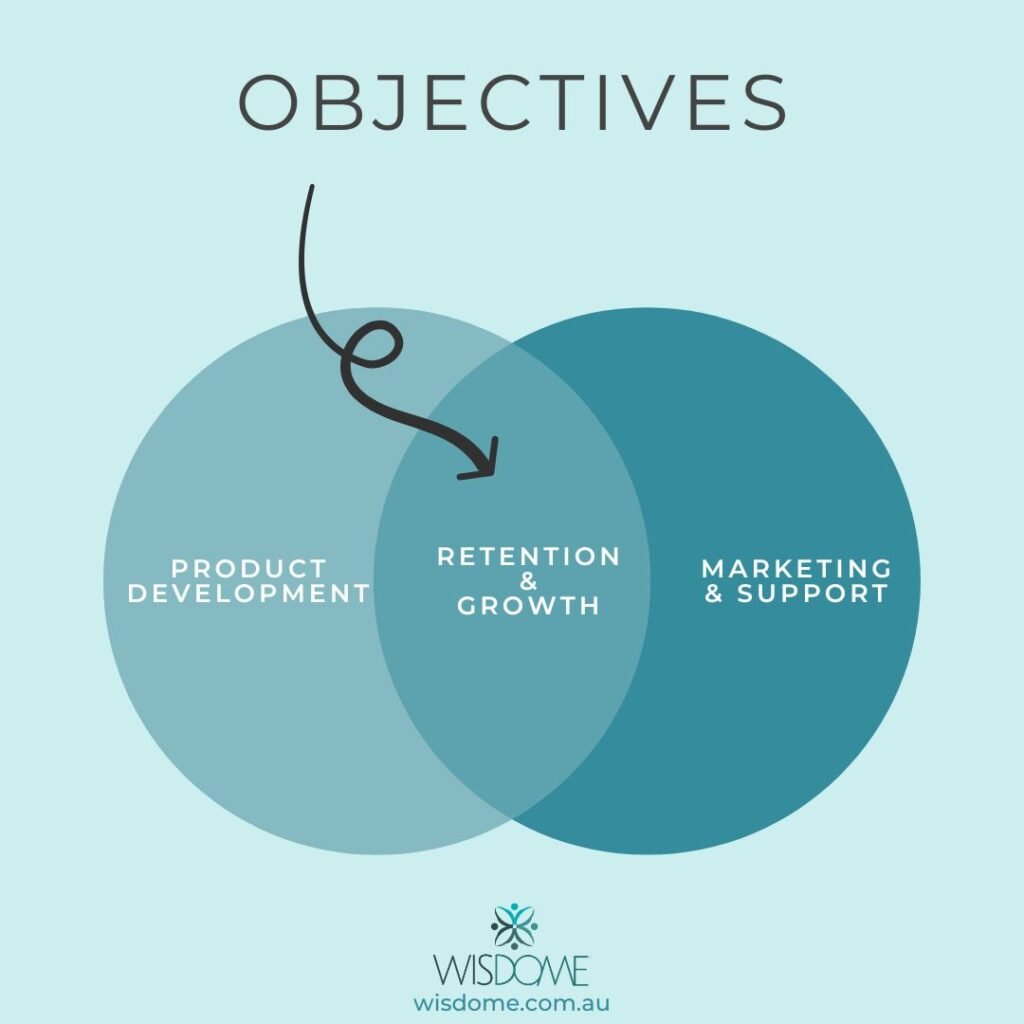Every brand constantly battles for visibility and success. Establishing a strong online presence is critical to stand out whether you’re an online coach, membership business owner, or course creator.
How should you allocate your resources between marketing your business and developing your product? This blog post explores the delicate balance between marketing and product development for knowledge sharers.
Read on and find inspiration on navigating the often-challenging waters of online business finances – one decision at a time. Here are some steps to help you achieve a balanced approach:
Set Clear Goals For Your Online Business

Understanding your short-term and long-term objectives can significantly ease the decision-making process when it comes to allocating resources. For knowledge sharers, striking a balance between content creation and marketing is crucial.
Remember, you need high-quality content to engage your audience. On the other hand, your audience must also know that your services exist so they can benefit from them.
How do you maximise your finances to allocate for marketing and content development? Ask yourself the following questions to help prioritise:
At this stage, which aspect is more important for me? Is it creating valuable content, or am I ready to market my services?

Do I have a course or a coaching package to help my target audience, or do I need to allocate more time to develop my content?
Your answer to these questions will reveal which area will need more budget to ensure success. Take the time to assess your goals and consider both your content development process and marketing needs.
Moreover, clear business objectives enable you to measure progress. By regularly monitoring your results, you can recalibrate your budget as needed. It will help you maximise the outcomes that align with your strategic goals.
Understand Your Audience
Business success means you must always consider what your audience wants and needs. You can do this through the following:
- Conducting surveys
- Analysing customer feedback
- Monitoring social media discussions
- Keeping up with industry trends
It would make sense to allocate a bigger budget to areas that need more attention or investment, depending on your situation. For instance, devoting more time to research and content creation should be a priority if you’re still developing your services.
Creating engaging material should also be a priority, like producing great videos. People are naturally drawn to videos because they offer a visually stimulating format. They also allow for the viewers’ emotional connection through visual imagery, making a lasting impact.
Additionally, consider using a combination of videos, downloadable ebooks, and audio content to add diversity and appeal to various learning styles.
Marketing should be the primary focus if your product or service is ready to capture the market share. Prioritise where the most value can be added and it will enhance your competitiveness in your online business.
Create a Business Roadmap
Create a comprehensive online course roadmap highlighting the valuable lessons and knowledge you’ll share with your audience. Leveraging customer feedback and current market demand, you can tailor your content to address everyday struggles and align with the ever-evolving trends in online coaching.
Knowing which topics to prioritise allows you to allocate resources efficiently. It will also ensure that your course remains relevant and engaging. Your roadmap becomes a strategic aid in planning your content development, helping you adjust time and budget for each module’s needs.
Embrace adaptability through your online course roadmap. In the world of online coaching, change is inevitable. A well-thought-out roadmap outlines milestones while retaining flexibility as you respond to market shifts, new client requirements, or unforeseen obstacles. This adaptability is a fundamental aspect of a successful roadmap.
Finally, enhance trust in your coaching brand by maintaining transparency with upcoming lessons, improvements, or bug fixes relevant to your online course. Sharing such information showcases your commitment to meeting participants’ expectations and cultivating their confidence in your expertise.
Optimise Your Marketing Expenses
Implement a data-driven approach to marketing for a more effective allocation of resources. Start by tracking and analysing key performance indicators (KPIs) to measure the effectiveness of your marketing campaigns. Important information that you should look into include:
Customer acquisition cost (CAC)
CAC is the total cost of attracting and acquiring new customers for a business. This includes expenses such as marketing, advertising, promotions, and sales efforts. To calculate CAC, divide the total acquisition cost by the number of customers acquired during a specific period.
Customer lifetime value (CLTV)
CLTV is the estimated net profit a customer will generate for a business over the entire relationship duration. It considers factors such as average purchase value, frequency of purchases, and customer retention rate. CLTV helps companies to understand how much they should invest in customer acquisition and retention.
Conversion rates
Conversion rates refer to the percentage of visitors or users who complete a desired goal or action, such as purchasing, subscribing to a newsletter, or signing up for an account.
A high conversion rate indicates that your marketing and user experience efforts resonate with your target audience and encourage them to engage with your business.
Return on investment (ROI)
ROI is a financial metric used to assess the efficiency and performance of an investment. It compares the net gain obtained from an investment to its initial cost. ROI helps businesses determine which investments yield the highest returns and allocate resources effectively.
Use these insights to optimise your marketing spend and focus on the channels that yield the highest ROI. By identifying areas where costs can be reduced without sacrificing performance, you can use your marketing budget more effectively and increase overall profitability.
Conclusion
A balanced approach between content creation and marketing is vital for the success of any online business. Setting clear goals, understanding your target audience, creating a business roadmap, and optimising marketing expenses are crucial steps to allocate resources and maximise outcomes efficiently.
Monitor your progress, so you can adapt to changes and prioritise investments according to your goals and market demands.
Remember that the essence of any business lies in its services. Striking the right balance ensures customer satisfaction and enhances your brand’s competitiveness in the online marketplace.





